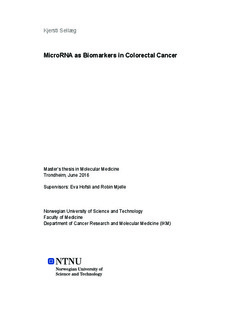| dc.description.abstract | Colorectal cancer (CRC) is one of the worlds leading causes of cancer-related deaths in both men and women. Nearly 1.4 million new cases were reported in 2012 and over half of the cases ended in death. High mortality rates are largely due to late diagnosis, at a stage when treatment efficacy is limited. Current methods for CRC detection and evaluation of prognosis and treatment response are compromised by limited sensitivity and specificity. MicroRNA (miRNA) are small RNA molecules that regulate gene expression by targeting messenger RNA (mRNA) transcripts. Aberrantly expressed miRNAs have been implicated as important players in CRC genesis, however, the functional role for many deregulated miRNAs in CRC are unknown. MiRNA is found in tissue and body fluids and have been proposed as potential non-invasive biomarkers in CRC. Total small RNA were isolated from serum of rectal cancer patients and prepared for high throughput sequencing. Patient data were collected from medical records to analyze the correlation between miRNA expression levels and clinical and tumor characteristics in order to identify candidate miRNAs. The effects of deregulated miRNAs in CRC tissue on cell growth were tested by transfection of miRNA mimics and inhibitors in the SW480 CRC cell line and measured by cell viability. Sequencing of isolated RNA identified 498 mature miRNAs and 3758 isomiRs. Several miRNAs and corresponding isomiRs (sequence variants) were significantly associated with metastasis at diagnosis, CEA levels and/or overall survival (miR-320a-e, miR-10a-5p, miR1246, let-7b-5p, miR-200c-3p and miR-29a-3p). Serum levels of miRNAs miR-10b-5p, miR215-5p and miR-150-5p, and isomiRs of miR-125b-5p and miR-30a-5p were significantly changed in CRC patients depending on whether patients had received preoperative treatment or not before serum was collected. Levels of two miRNAs, miR-451a and miR-877-5p, correlated with hemoglobin levels. In the functional assay, several miRNA inhibitors had a significant growth inhibitory effect on CRC cells (e.g. miR-183, miR-182, miR-96, miR-31-5p and miR-18a-3p). It seemed that some miRNA mimics, at least in some part, caused a decrease in CRC cell growth, but were not significant in our experiment. VI In conclusion, the present study showed that several aberrantly expressed miRNAs in CRC tissue play important roles in growth of CRC cells, and that several miRNAs, including miR320a-e, miR-10a-5p, miR-1246 and let-7b-5p, and miR-10b-5p, miR-150-5p, miR-215-5p and miR-125b-5p are potential prognostic and predictive biomarkers in CRC. Our findings also suggest that isomiRs may provide an additional layer to CRC biomarkers beyond mature miRNAs. Validation in large-scale studies and assessment of specificity and sensitivity is needed to determine the clinical application of these biomarkers. | nb_NO |
